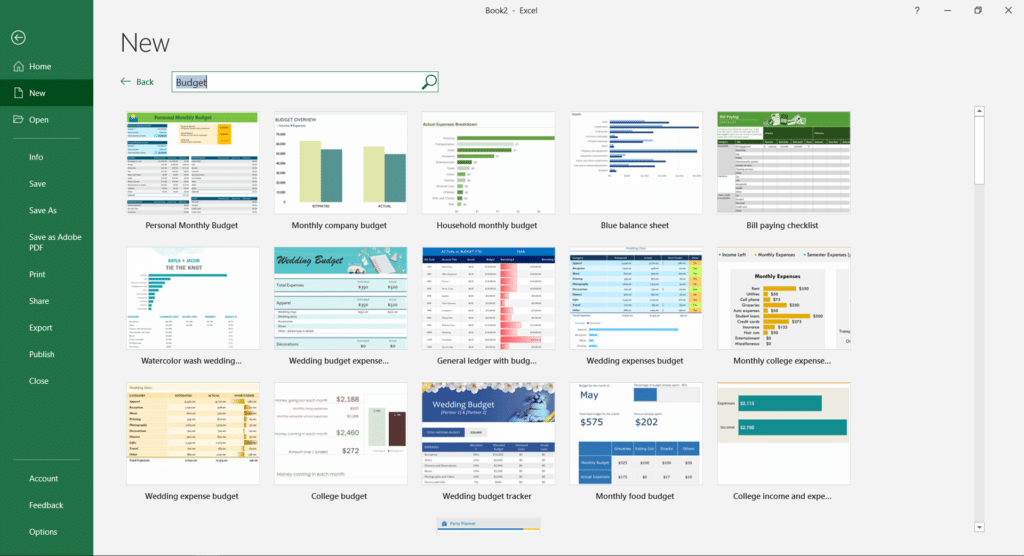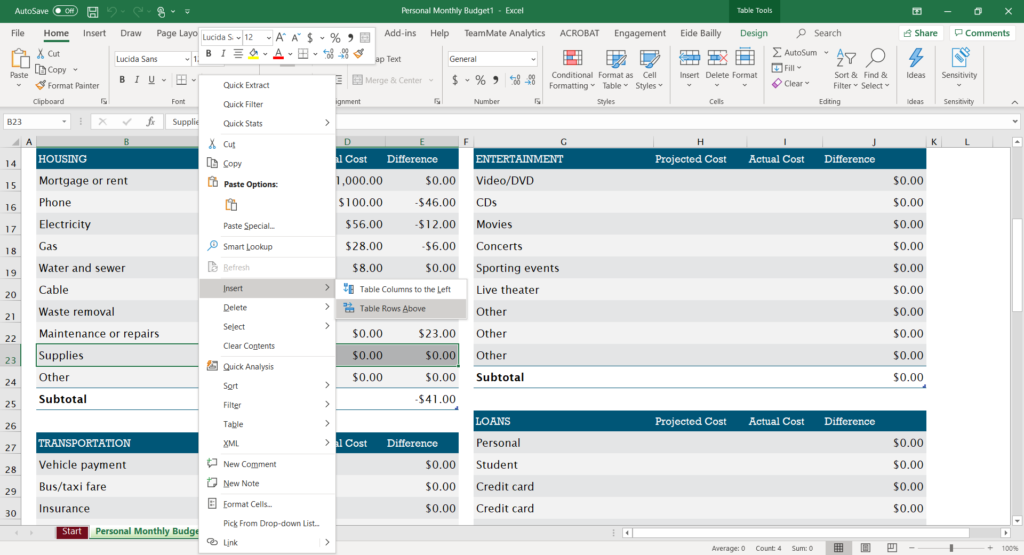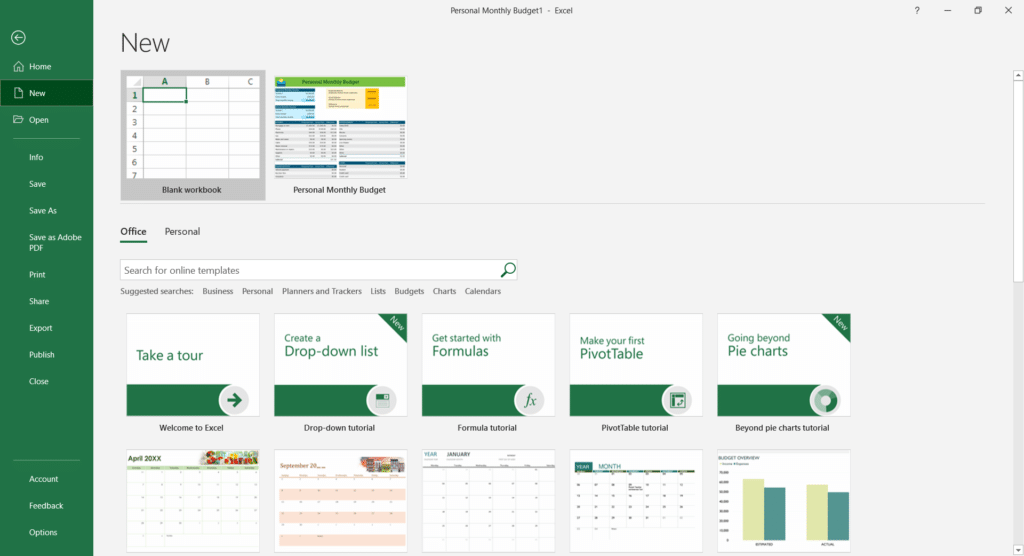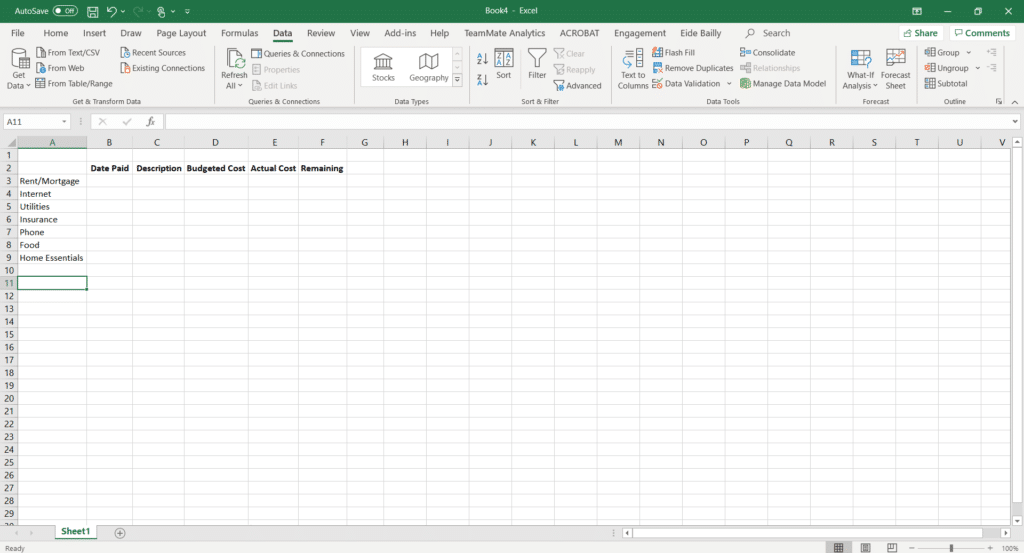The key to getting your finances under control is making and following a budget. But how do you go about doing that? There are plenty of paid and free apps out there, but the simplest way is to use software many people already have on your computer: Excel. Even if you’ve never touched Excel in your life, you can still use it to create and regularly update a monthly budget.
The steps for how to create a budget in Excel are simple, especially if you use a template. You can also create your own budget using a blank workbook, labeling fixed and discretionary expenses, and adding income information.
How to Make an Excel Budget with a Template
To make your life simpler, an Excel budget template already exists in the program. You just have to open it up, save it, and customize it. To create a budget from an Excel template, follow these steps:
- Open up Excel.
- Click File, then New from Template.
- In the window that opens, search for “budget.”

At this point, several options will populate the window. Find one that looks clean and simple, and that will work for your individual or family budget.
- Select a budget template. It will open, and you can begin entering information and customizing the categories.
- To change a number value or category label, click on the box it appears in (called a “cell”) and edit the text in the bar at the top of the spreadsheet.
- If you need to add more categories, right-click where you want to insert new information and select either add row or add column.

Even if you decide not to stick with an Excel budget template, using a premade monthly budget template will help you get a good idea for what kinds of categories and information you should include in your budget.
How to Make a Budget in Excel from Scratch
If the Excel budget templates look too confusing, or if you want more room for customization, you can make a budget spreadsheet from scratch. The process is fairly simple. Here’s how to make a budget in excel from the ground up.
1. Open a Blank Workbook
A document in Excel is called a “workbook.” When you open Excel, choose Blank Workbook or go to File and select New Workbook. Your fresh, empty workbook will open, ready to be molded into your new budget.

2. Label Fixed Expenses
In your budget, you will have fixed expenses—bills you need to pay every month—and discretionary expenses. Start your budget by listing out your fixed expenses. Common examples include rent or mortgage, utilities, insurance, monthly debt payments, internet bill, etc.
List each of these expenses in column A, starting in row 2 (leave row 1 blank). In columns B to F, add these labels to help you track how much you spend in each category:
- B, Date Paid: You will note the date you made the payment (if it makes more sense to you, you can change this to due date).
- C, Description: Add any details about the expense to help you (and anyone else using the budget) understand the category.
- D, Budgeted Cost: How much money you plan to spend in this category for the month.
- E, Actual Cost: How much money you actually spent.
- F, Remaining: Actual cost subtracted from budget cost—this number may be negative sometimes.

In column C, after you’ve listed all of your bills, type “Bills Total.” Place your cursor in column D, the “Budgeted Cost” column, and click the SUM button at the top of the bar. This will automatically add up all of your budgeted costs for each bill. The SUM button is a great tool in using your Excel budget. Do the same thing under column E, “Actual Cost.” These sums will show you at a glance how much money you’ve budgeted and spent.

3. Label Discretionary Expenses
After your fixed expenses, you need to list your discretionary expenses. List out a few categories you want to include: transportation, home repairs, restaurants, groceries, etc., and determine how much you want to budget for each category.
For example, if you budgeted $700 for groceries this month, you’ll type “Groceries” in column A, and $700 in column D. Each time you go to the grocery store during the month, use columns B and C to enter when and where you shopped, respectively, your monthly budget ($700) in column D, and the amount you spent in column E. In column F, “remaining,” you’ll subtract how much you spent from your budget, and easily see how much money you have left for groceries that month.
Hint: You can get Excel to do the math for you by clicking in column F, going to Formulas, then hitting the SUM button, and in the bar above, you’ll see a formula—switch out the colon for a minus sign to subtract instead of add, then click Enter. Your formula will look something like this: =SUM(D9-E9).
Next time you go to the grocery store, you’ll do the same thing—enter in your purchase. But this time you’ll subtract what you spent on your trip (column E) from the amount remaining (column F) from the previous trip.
Now you’re ready to start tracking your expenses. Next, we need to add a place to track income.
4. Add Income Information
Scroll to the right, and in the first row on columns H to J, add these labels:
- Income: Under this column, list all your sources of income, including your paycheck, your spouse’s paycheck, income from investments, social security, etc.
- Planned: How much you expect to earn from each category this month.
- Received: How much you earn from each category this month.

In these columns, you will track how much income you expect for the month, and how much you actually receive. To calculate your total planned and received income, highlight all the values and click the SUM button. Below the column, you’ll see the total income you expect for the month.
Get Started Today
Creating a budget in Excel doesn’t have to be difficult or time-consuming. With these simple steps, you can start a basic budget to help you track your income and expenses. A budget is key to gaining control over your finances—but the first step is to be consistent in filling out your expenses and making adjustments every month to how much you spend and budget to make sure you have money for what’s important.
Are you struggling under a mountain of debt? Find out how to get out of debt today!









